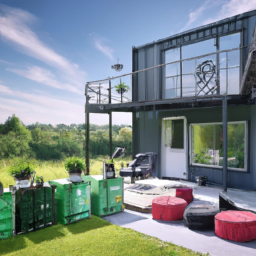Living off-grid has gained significant popularity in recent years, with more people seeking sustainable and alternative ways of living. An increasingly popular option is the use of shipping container homes, providing an environmentally friendly and affordable housing solution. However, before embarking on this unique endeavor, one must consider the crucial question: Where can I put a shipping container home in the UK? This article explores the various locations and regulations that individuals need to be aware of when looking to establish their shipping container home in the UK, offering valuable insights and guidance for those eager to embrace off-grid living.
Shipping Container Home Overview
What is a shipping container home?
A shipping container home, also known as a container house, is a dwelling that is constructed using repurposed shipping containers. These containers, typically made of steel, are designed to transport goods globally. However, due to their robustness and versatility, they can be converted into livable spaces that offer unique and innovative housing solutions. With the growing interest in sustainable living and the need for affordable housing options, shipping container homes have gained popularity in recent years.
Benefits of a shipping container home
Shipping container homes offer a multitude of benefits that make them an attractive option for individuals seeking alternative housing solutions. One of the primary advantages of a container home is its affordability. Compared to traditional housing, the cost of purchasing and converting a shipping container into a livable space is significantly lower. Additionally, as these containers are readily available and easy to transport, they provide a quick and efficient solution for those in need of immediate housing.
Furthermore, shipping container homes are highly sustainable. By repurposing these containers, we reduce the demand for new construction materials, thereby minimizing the environmental impact of housing projects. Container homes also offer the potential for off-grid living, as they can be equipped with renewable energy sources such as solar panels and rainwater harvesting systems. This self-sufficiency allows residents to reduce their ecological footprint and live in harmony with the natural environment.
Moreover, shipping container homes are known for their durability and resilience. These structures are designed to withstand the harshest of conditions, including extreme weather events and transportation across continents. As a result, container homes are not only built to last but can also provide added safety and security for their inhabitants.
Legal Considerations
Local planning regulations
Before embarking on a shipping container home project, it is vital to familiarize oneself with the local planning regulations. These regulations vary depending on the region and may restrict or regulate the construction of container homes. Some areas have specific zoning requirements or size limitations for alternative dwellings, including container houses. Understanding the local regulations ensures compliance and avoids potential legal challenges during the construction process.
Building permits and permissions
Obtaining the necessary building permits and permissions is another critical aspect of building a container home. Like any other residential construction project, container homes require the appropriate permits to ensure that the structure meets safety standards and adheres to local building codes. These permits may involve inspections by local authorities and may require the submission of architectural plans and engineering specifications. Failure to secure the required permits can result in delays, fines, or even the demolition of the structure.
Environmental impact assessments
When considering the construction of a shipping container home, it is important to assess its environmental impact. While container homes are generally considered eco-friendly due to their use of recycled materials, certain environmental factors need to be considered. These include the site’s impact on surrounding ecosystems, water and waste management systems, and energy efficiency. Conducting an environmental impact assessment helps identify potential issues early on and enables the implementation of measures to minimize the ecological footprint of the container home.
Choosing the Ideal Location
Type of land required
Selecting the ideal location for a shipping container home is crucial to ensure its long-term viability and suitability. When evaluating potential sites, one must consider the type of land required for the construction. Container homes typically require flat or gently sloping land without any major geological or structural challenges. The stability of the ground and soil conditions play a significant role in determining the feasibility of the project and the cost of site preparation.
Access to utilities
Access to utilities is another critical factor to consider when choosing the location for a shipping container home. Basic necessities such as water, sewage systems, electricity, and gas connections are essential for a comfortable and functional living environment. While container homes can be designed to be off-grid, many individuals still prefer to have access to essential amenities. Therefore, proximity to utility connections or the feasibility of implementing alternative energy sources should be taken into account when selecting a suitable location.
Distance to amenities
The proximity to amenities is an important consideration for individuals planning to live in a shipping container home. Access to services such as schools, healthcare facilities, grocery stores, and transportation networks greatly impacts the daily convenience and quality of life. Evaluating the distance to these amenities and assessing the availability of public transportation options is crucial to ensure that the chosen location meets the practical and social needs of the residents.
Land Ownership Options
Buy a plot of land
One option for acquiring land for a shipping container home is through the purchase of a plot of land. This involves identifying suitable land for sale that meets the necessary requirements for constructing a container home. It is important to consider factors such as location, access to utilities, zoning regulations, and the overall cost of the land. Engaging the services of a reputable real estate agent specializing in alternative dwellings can be beneficial in finding the right piece of land for a container home project.
Lease land
Leasing land is another viable option for individuals interested in building a shipping container home. This arrangement allows for the temporary use of a specific piece of land without the long-term commitment and financial burden of purchasing it outright. However, leasing land typically involves negotiating lease terms, including the duration, rent, and any restrictions set by the landowner. It is essential to thoroughly review the lease agreement and seek legal advice to ensure that it aligns with the specific requirements of a container home project.
Join a co-housing community
For those seeking a sense of community and shared resources, joining a co-housing community can be an attractive option. Co-housing communities consist of individuals or families living together in a planned neighborhood, where each household has their private living space while sharing common areas and resources. These communities often have a shared vision of sustainable living, making them an ideal fit for container homes. Co-housing communities can provide a supportive network, cost-sharing opportunities, and a sense of belonging for those interested in the shipping container home lifestyle.
Popular Locations for Shipping Container Homes
Rural areas
Rural areas are often preferred by individuals seeking to build shipping container homes due to the availability of larger plots of land and fewer zoning restrictions. The expansive landscapes and serene environments make rural locations a perfect setting for those seeking a tranquil and self-sufficient lifestyle. Additionally, the lower land prices in rural areas make it more affordable to acquire the necessary land for a container home project.
Urban areas
While urban areas may pose more challenges in terms of land availability and zoning restrictions, they can still be suitable locations for shipping container homes. Urban container homes offer the advantage of convenience, with easy access to amenities, employment opportunities, and cultural attractions. In densely populated cities, container homes can provide an innovative solution to the affordable housing crisis and contribute to urban regeneration initiatives.
Coastal regions
Coastal regions are often popular choices for shipping container homes due to their beautiful scenery, proximity to beaches, and recreational activities. Container homes can offer an affordable and sustainable way to enjoy coastal living while minimizing the impact on fragile ecosystems. However, it is important to consider the unique challenges posed by coastal environments, such as saltwater corrosion, potential flooding, and the need for robust structural designs to withstand strong winds.
Remote off-grid locations
For those seeking a truly off-grid lifestyle, remote locations away from urban centers provide the perfect setting for shipping container homes. These locations offer the opportunity to disconnect from the hustle and bustle of modern life and immerse oneself in nature. Off-grid container homes can be powered by renewable energy sources, rely on rainwater harvesting, and promote sustainable practices, allowing individuals to live in harmony with their surroundings.
Finding Land for Your Shipping Container Home
Real estate agents
Engaging the services of a reputable real estate agent can greatly facilitate the process of finding land for a shipping container home. Experienced agents specializing in alternative dwellings are knowledgeable about the specific requirements and challenges associated with container home projects. They can help identify suitable land options, negotiate prices, and ensure that the chosen locations meet all necessary legal and practical considerations.
Online platforms
In today’s digital age, online platforms have become a valuable resource for finding land for various purposes, including shipping container homes. Websites and platforms dedicated to real estate listings enable individuals to search for available land based on specific criteria such as location, size, and price. Online platforms allow for broader access to a wide range of properties, increasing the chances of finding a suitable piece of land for a container home project.
Networking with like-minded individuals
Networking with like-minded individuals within the shipping container home community can provide valuable insights and opportunities for finding land. Participating in online forums, social media groups, or attending container home-related events can connect individuals with others who are either selling land suitable for container homes or have knowledge of potential opportunities. Collaborating with fellow container home enthusiasts not only expands the network but also allows for shared experiences and information exchange.
Designing and Building Your Shipping Container Home
Architectural plans and permits
The design and construction of a shipping container home require careful planning and adherence to architectural plans and permits. Engaging the services of an experienced architect or designer who specializes in alternative housing can ensure that the container home is designed to meet both aesthetic and functional requirements. These professionals can create detailed plans and specifications, considering factors such as structural integrity, insulation, natural lighting, and ventilation. Additionally, they can assist in obtaining the necessary permits from local authorities, ensuring compliance with building codes and safety regulations.
Choosing a reputable contractor
Selecting a reputable contractor is essential to ensure the successful construction of a shipping container home. Contractors with expertise in container home construction have the necessary knowledge and skills to handle the unique challenges posed by these structures. It is important to thoroughly research contractors, review their previous work, and seek recommendations from others in the container home community. By choosing a reputable contractor, individuals can have confidence in the quality of workmanship and timely completion of their container home project.
Interior and exterior customization
One of the advantages of shipping container homes is the ability to customize both the interior and exterior according to personal preferences and requirements. The interior layout can be tailored to fit individual needs while maximizing the available space. Amenities such as kitchens, bathrooms, and sleeping areas can be efficiently integrated into the container home design. Likewise, the exterior can be enhanced with various finishes, cladding options, and insulation materials to enhance the aesthetics and energy efficiency of the structure.
Financing Your Shipping Container Home
Budgeting and cost estimation
Before embarking on a shipping container home project, it is essential to establish a comprehensive budget and conduct a cost estimation. This involves considering various factors, including the purchase of containers, site preparation, architectural design, construction labor, materials, permits, and other associated expenses. By accurately estimating the costs involved, individuals can plan their finances accordingly and avoid any financial setbacks during the construction process.
Mortgages and loans
Financing a shipping container home can be achieved through various methods, including mortgages and loans. While container homes are gaining recognition as viable housing options, it is important to note that not all traditional lenders may provide financing for such projects. Researching specialized lenders or financial institutions that cater to alternative housing can provide options for securing a mortgage or loan specifically tailored for shipping container homes. The eligibility criteria for these loans may vary, and it is advisable to consult with financial experts well-versed in the nuances of container home financing.
Crowdfunding and investment opportunities
For those seeking alternative financing options, crowdfunding and investment opportunities can provide viable alternatives. Crowdfunding platforms specifically tailored for sustainable housing projects may allow individuals to showcase their container home project to a broader audience and seek financial support. Additionally, partnerships or investment opportunities with like-minded individuals or organizations that align with the vision of sustainable living can provide the necessary funds to bring a shipping container home to fruition.
Living in a Shipping Container Home
Sustainable practices
Living in a shipping container home often goes hand in hand with adopting sustainable practices. These eco-friendly dwellings provide an opportunity for residents to minimize their environmental impact and contribute to a greener lifestyle. Implementing energy-efficient appliances, utilizing renewable energy sources, practicing water conservation, and adopting recycling and waste management practices are all essential components of sustainable living in a container home. By making conscious choices and embracing sustainable practices, individuals can reduce their carbon footprint and live in harmony with the environment.
Community engagement
Container homes can also foster a sense of community engagement and collaboration. Engaging with neighbors and like-minded individuals in the container home community can provide opportunities for shared resources, knowledge exchange, and support. Participating in local initiatives, neighborhood events, and community projects can enhance the social fabric and promote a sense of belonging for container home residents. Additionally, contributing to wider sustainability efforts by organizing educational programs or participating in environmental initiatives can positively impact the community at large.
Maintenance and upkeep
Like any other home, shipping container homes require regular maintenance and upkeep to ensure their longevity and functionality. Due to the materials used and the unique characteristics of container homes, specific maintenance tasks may be required. These can include regular inspections for rust or corrosion, sealing and weatherproofing measures, paint touch-ups, and checking the structural integrity of the containers. Following proper maintenance practices and addressing any issues promptly can help preserve the integrity of the container home and ensure a comfortable living environment.
Conclusion
Shipping container homes offer a unique and innovative housing solution that combines sustainability, affordability, and versatility. From understanding the legal considerations to choosing the ideal location and financing the project, individuals interested in building a container home need to navigate through various aspects of the process. By carefully considering each step, engaging with professionals, and embracing sustainable practices, individuals can create a beautiful and functional living space that reflects their values and aspirations. Ultimately, living in a shipping container home can provide a rewarding and environmentally conscious way of life, contributing to a more sustainable future.




